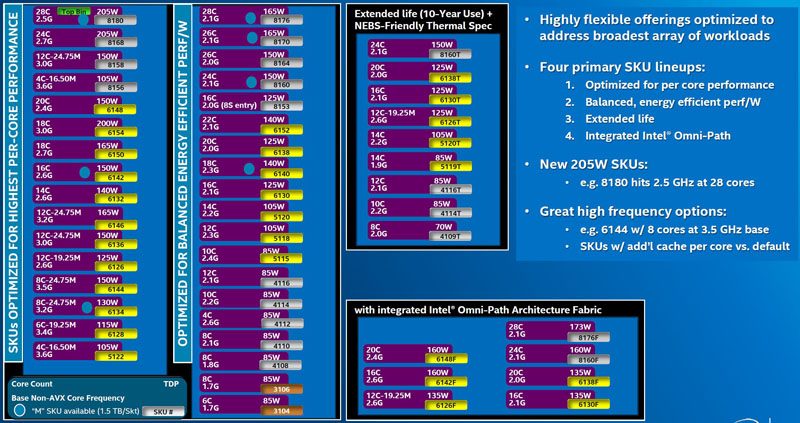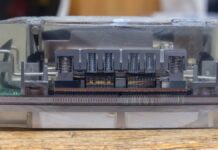It is little secret in the industry that Intel has bigger CPUs that are going to cost substantially more with the Intel Xeon Scalable Family. How much more? One example would be to compare the Intel Xeon E7-8891 V4, the top end Broadwell-EX SKU with an equivalent Intel Xeon Platinum 8180M SKU. There the list price almost doubled from around $7,000 to around $13,000 generation to generation. If that offends sensibilities, remember that the Xeon Platinum 8180M is targeted at servers where RAM costs per socket will exceed $70,000. Intel is trying to capture that value. On the other hand, in single and dual socket configurations the $13K Intel Xeon Platinum 8180M now has competition in the AMD EPYC which can handle 33% more memory even at around $4K for the 32 core 7601 SKU.
Update 2017-07-12: We were working off of the price list Intel sent us the morning of launch. Updated a few entries on the list based on Ark information.
The Intel Xeon Scalable Processor Family SKU List
Here is the initial slide we received with all of the different SKUs for the launch. Intel, of course, has more SKUs available but this is a good slide to discuss positioning.

We do have an entire piece on the different Platinum, Gold, Silver, Bronze families that is worth a look. While the number of SKUs may seem like a lot, if you take the Intel Xeon E5-2600, Intel Xeon E5-4600 and Intel Xeon E7 series parts as a starting point, then this list represents a reduction in total SKU counts.
The Intel Xeon Scalable Processor Family Value Analysis
Before we go further, we wanted to add two prior generation value analysis charts from the Intel Xeon E5-2600 V4 and Intel Xeon E5-4600 V4 series. The high-memory capacity Xeon E7 series pricing is dominated by RAM costs, and often software license costs, so CPU pricing on that end is a relative drop int he bucket.
Slight Updates from Our Intel Xeon E5 and E7 V4 Lists
With the new CPUs, we are going to add features we have added from our Intel Xeon E3-1200 V6 value comparison, namely using HT threads as a 30% addition instead of a 100% addition in our value comparisons. This gives a better “back of the envelope” multi-threaded performance estimation for value purposes. You can find that in Adjusted Thread GHz * Base Clock / Price abbreviated as Adj T*B/Price columns in our charts.
Intel Xeon Scalable Processor Family Value Comparison
Here is the full list. This is completely unmanageable so we are going to take a few slices to discuss.

All told, we already have evidence of 58 SKUs. This number is likely to increase over time. Here are a few notes:
- Cache numbers in bold have more cache than 1.375MB/ core.
- The Intel Xeon Gold 5100 series lacks the third UPI link so we are unlikely to see them in 4 socket configurations.
- The Bronze CPUs do well here and are going to make the Intel Xeon E3-1200 V6 family even more squeezed into smaller form factor requiring higher clocks and less memory configurations.
- There may be errors. We had to do manual data entry with this to have it up for launch.
- Please do not hotlink these images as the context is important.
Intel Xeon Scalable Processor Family High Memory Capacity Value Comparison
First, we are going to use the high-memory capacity “M” SKUs. These parts will typically have extremely high memory and software license costs.

Here you can see that the top end SKU performs fairly well with its higher TDP. The Intel Xeon Platinum 8180M and 8176M should have the same 3.8 core single core non-AVX turbo boost. On a relative scale, the Xeon Platinum 8180M looks like a bargain. The bottom end of the Platinum and top end of the Gold SKUs look great from a value perspective. On the Intel Xeon Gold 6134M it is a part specifically targeted with fewer cores and higher core counts for environments where software licensing is per core.
Intel Xeon Scalable Processor Family Platinum and Gold 6100 Series Comparison
We are splitting the Gold series in two as one is a significantly higher part. We, therefore, have the Xeon Platinum and Gold 6100 chips in this comparison.

7 of the 24 parts here have greater than 1.375MB L3 cache per core. That high of a ratio shows just how important software license costs are to customers. Intel can increase cache sizes and thus performance without increasing core counts. That helps with software licensed on a per core basis.
Intel Xeon Scalable Processor Family Gold 5100, Silver and Bronze Comparison
These are the lower core count, lower feature set, and lower price parts.

The standouts here are really the Bronze parts. The Intel Xeon Gold 5122 is a CPU with a mission. Lots of cache and clock speeds with minimal cores for only $1221. If you are running a database application, and do not want to go higher in the stack, this is one to look out for.
The Intel Xeon Silver series is priced to be Intel Xeon E3-1200 V6 killers and the TDP are similar to the lower-end parts. You also get the much improved I/O capabilities of the Skylake-SP family so we are going to recommend the Intel Xeon E3-1200 V6 parts now only in the narrowest of situations.
Intel Xeon Scalable Processor Family Omni-Path for $155
We knew integrated 100Gbps Intel Omni-Path fabric was going to be inexpensive, but not at an even lower cost than Knights Landing:

That is around $155 for adding an Intel Omni-Path 100Gbps RDMA capable fabric per CPU. Better still, adding this also saves a PCIe x16 slot on each CPU.
Mellanox should be scared at 100Gbps, although they are pushing towards 400Gbps.
These OPA parts are incredible values.
Extended Lifecycle and Thermal Parts
There is a segment of the market that needs up to a 10-year product lifecycle and extended environmental ranges.

Here, we see a limited stack but it does cross the majority of the range.
Final Words
Our theory here is that Intel is raising list price ranges so that it has the potential to discount more heavily in the future. We have not heard this from major customers and OEMs but we do hear Intel is seeing competitive pressure for the first time and now has more margin to use discounts as a competitive tool. If you are buying a CPU in the sub $3000 level for a non-virtualized application such as a Docker host or storage server, there are now other options at play. Intel does have more performance but with this generation, Intel is charging a lot more than its competition for platform-level features.
The Intel Xeon E3-1200 V6 line just launched, but the new Silver and Bronze CPUs make them a tough sell in the vast majority of cases. If Intel were trying to phase out the GPU-less E3 line over time, this is a textbook first step.
In these servers, it is rarely the CPUs that dominate the conversation in terms of costs. Usually, RAM pricing, drive pricing, software licensing and operational costs dominate TCO comparisons. We do see some portions of the stack where identical core counts have been lowered. The Intel Xeon Gold 6142 has the same core count and similar clocks to the Intel Xeon E5-2699 V4 but at a lower price as an example, and it provides a much better architecture and platform than the older generation part. At the same time, there is now a major competitor in AMD EPYC that has up to 32x lower performing cores per socket at just over $4200 each and can handle up to 2TB of RAM per socket even at the several hundred dollar 8 core SKU range.
Suffice to say, things are getting interesting. We have about 10% of the lineup already benchmarked and will be releasing that data after launch along with AMD EPYC performance to show how that side of the equation pans out. When comparing processors, these analysis tables should help one make back of the envelope decisions.





Please correct in few tables – 6130 CPU is 16 cores
The BRONZE series (per ark.intel.com) do not have hyperthreading. Your big chart (Intel Skylake SP Value Comparison Full Family Analysis Chart) shows 3106 as 8 cores with 16 threads, and 3104 with 6 cores and 12 threads. ark says 3106 8/8 and 3104 6/6, no hyperthreading. This significantly changes the value rating with half the threads.
Thanks Damir and Mark. Will make these changes in the next revision. The official list we got with prices the morning of launch matches what we posted.
Would it be possible to make these excels public?